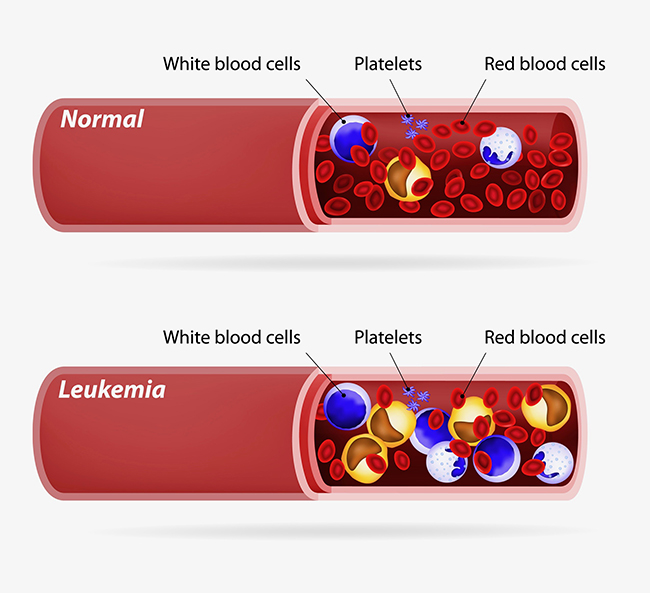Understanding Pediatric Leukemia
Pediatric leukemia is a cancer that begins in a child’s bone marrow, where blood cells are made before they enter the bloodstream. It’s important to know:
- Leukemia is the most common cancer in children.
- Doctors can now successfully treat and cure most children with leukemia.
- Scientists don’t know the cause of most childhood leukemias.
- Pediatric leukemia includes many subtypes, which vary in severity and treatment.
- CAR T-cell therapy is a breakthrough for some rare cases of childhood leukemia.
What is pediatric leukemia?
Leukemia is a cancer in which a child’s bone marrow makes abnormal blood cells, most often white blood cells.
Normal white blood cells help your child fight infection. Leukemia cells don’t fight infection.
With leukemia, the abnormal white blood cells crowd out other blood cells:
- Red blood cells that carry oxygen through the body
- Platelets that help blood clot
This imbalance affects how your child’s organs work. It also keeps red blood cells and platelets from doing their jobs.

Who gets pediatric leukemia?
While leukemia is somewhat rare in adults, it is the most common form of cancer in children.
- About 28% of all childhood cancers are leukemia.
- About five in 100,000 children in the U.S. will be diagnosed with leukemia this year.
What causes pediatric leukemia?
Scientists don’t yet know. There is nothing anyone could have done to prevent it.
Types of pediatric leukemia
Most childhood leukemia is one of three types.
This is by far the most common childhood leukemia, making up about three in four cases. It occurs when your child’s bone marrow produces too much of a type of white blood cell called a lymphoblast. The “acute” in ALL means it usually spreads quickly if not treated.
AML is the second most common childhood leukemia. It occurs in about one in five cases. It starts in myeloid cells, which normally develop into cells that fight infection. Instead, your child’s body makes a large number of abnormal blood cells. Like ALL, it usually spreads quickly if not treated.
This type is rare in children. It happens when your child’s bone marrow makes an abnormal number of myeloid cells. Unlike AML, CML tends to spread slowly. Some subtypes can be more challenging to treat. The best treatment for CML was developed by researchers at OHSU and is used world-wide.
Pediatric leukemia survival rates
Leukemia treatment has come a long way over the past 40 years. It’s now successfully treated in most children.
On average, nearly 85% of children with pediatric leukemia survive five years or more after their diagnosis. The five-year survival rate is a standard way of measuring cancer outcomes.
Children with ALL or AML who are cancer-free after five years are likely cured. It is extremely rare for acute leukemias to come back after this long.
- For ALL: Nearly 92% of children who are younger than 15 years old when diagnosed are free of leukemia five years later.
- For AML: Survival rates vary depending on the subtype. About 69% of children younger than 15 are free of leukemia five years later.
- For CML: Nearly 70% of children younger than 15 are free of leukemia five years later.
It’s important to remember that all of these rates are averages. They can’t predict the outcome for your child’s individual circumstances.
Symptoms of pediatric leukemia
Symptoms of leukemia are similar to many other conditions.
Low numbers of normal blood cells can cause a variety of symptoms:
- Low red blood cells (anemia)
- Paleness
- Lightheadedness and tiring easily
- Headache
- Low white blood cells
- Repeated, frequent infections
- Low platelets
- Easy bleeding and bruising
If leukemia spreads from the bone marrow to other organs, it can cause:
- Swollen lymph nodes (small glands that help your child’s body filter toxins) or lumps in the underarm, groin, neck or other parts of the body
- Swollen liver or spleen
Other symptoms include:
- Pain from pressure in the bone marrow can cause irritability and refusal to walk in young children.
- As your child’s immune system fights leukemia, they may have frequent or long-lasting fevers.
Pediatric leukemia classification
Treatment for childhood leukemia varies based on its type and subtype. ALL and AML are fast spreading (acute). CML is slow spreading (chronic). ALL and AML have subtypes.
Subtypes of ALL are mainly based on the type of cell where your child’s leukemia starts.
- B-cell ALL starts in B lymphocytes — also called B cells — which protect your child’s body from germs by making antibodies. B-cell ALL has several subtypes.
- T-cell ALL starts in T cells, which normally recognize and destroy cells with viruses.
AML has many subtypes. Your child’s doctor will classify it based on factors such as:
- The type of bone marrow cell where the leukemia started.
- Whether the leukemia cells have specific changes in genes or chromosomes.
- Whether the leukemia is related to chemotherapy or radiation used to treat a previous cancer.
- Whether your child also has Down syndrome.
Doctors categorize CML based on how many immature white blood cells, or blasts, are found in your child’s blood or bone marrow.
- The chronic phase is an early stage with mild symptoms.
- The accelerated phase has more noticeable symptoms such as fever, night sweats and weight loss.
- The blast phase is more aggressive, as leukemia cells spread to tissues and organs throughout the body.
Learn more
Learn more about leukemia from the National Cancer Institute.
For families
Call 503-346-0640 to:
- Request an appointment.
- Seek a second opinion.
- Ask questions.
Locations
Parking is free for patients and their visitors.
Doernbecher Children’s Hospital
700 S.W. Campus Drive
Portland, OR 97239
Map and directions
Find other locations across Oregon and in southwest Washington.
Refer a patient
- Refer your patient to OHSU Doernbecher.
- Call 503-346-0644 to seek provider-to-provider advice.